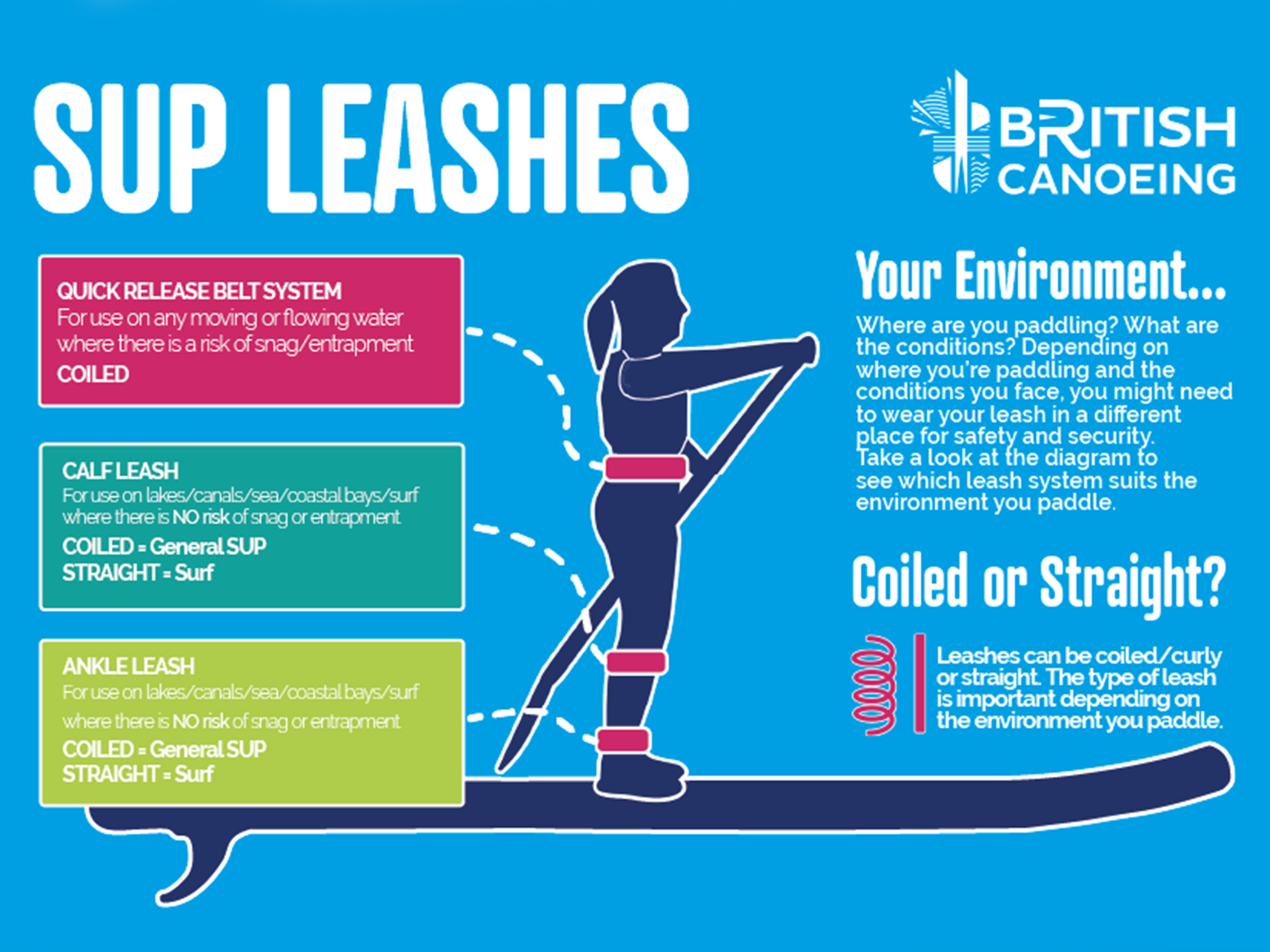
(See picture above from British Canoeing - choosing the correct leash)
SUP leashes are an essential piece of kit for any paddler. It should never be a question of whether or not you should wear a leash - the focus should be finding the correct leash set up for the activity and environment.
Leashes are a secure way to remain attached to your board, they fasten easily onto the D-rings on your SUP. It is important to consider the area you are paddling in and all the safety options available before setting out on the water. There are a variety of leashes you can buy and we have broken these down for you below to help you decide on the correct leash.
As standard there are two types of leash. There are coiled leashes which are mainly used for flat water, and straight leashes which are used in surf and other general paddling. One of the pros of using a coiled leash is that they rest on the board rather than being submerged in the water. This means there is less drag and chance of them being caught on something. Coiled leashes are recommended only for flat water use as if used in surf there is too much chance of your board springing back. Straight leashes are preferable in the surf as it avoids springback and leaves the deck of your board clear to move around on. These leashes are considered to be more universal as they can also be used on flat water.
Most SUP leashes tend to fit around the ankle or calf, however it is possible to buy leashes with a quick release mechanism which attaches to a belt worn around the waist, these are generally made to a specific size so ensure that you try it on to ensure the fit before entering the water. You can also convert a standard ankle/calf leash into a waist leash very simply. This is popular for use in moving water as it allows for quick and easy release from the board. The lack of drag in the water makes it easier to manoeuvre. For example, in races these are perfect as the quick release function means it can be very useful for the final dismount and sprint of a race.
Waist leashes are becoming more popular due to the added safety of the quick release mechanism, they can be worn on their own or as part of a buoyancy aid or hydration pack. To release the paddler from the board, there is usually a buckle with a toggle which can be pulled open. For white water, these waist leashes are essential as the quick release can be vital when you need to release your board quickly if a difficult situation should occur.
It is important to look after and maintain your SUP leash as it is a key piece of safety equipment. Over time and wear from being used in the water or wrapped around the board during storage, the leashes can develop kinks and the urethane can become damaged. Wherever possible, store your leash carefully alongside your board and keep out of sunlight. Regularly check your leash for signs of damage and be sure to replace it if you notice any wear or tear. This piece of equipment could save your life so must be looked after well.
It is never safe to be out on your SUP without a leash and it is equally as important to choose the correct leash for your board and paddling environment. Take into account the size of your board and the type of water you will be paddling on before purchasing a leash. Be aware that leashes can become caught on obstacles in water including but not limited to tree branches, rocks, pontoons, buoys as well as other people and their equipment. If you are planning on getting in or out of the water, consider the risk of wearing your leash at that moment. It is better to remove the leash to lose your board and enter the water safely than risk getting pinned under.
These are some of the key points to consider when selecting a safety leash and may explain the reason why more and more paddlers are leaning toward the waist leashes with easy to access quick release. These quick release belts should be made free of velcro as this can impact ease of release as well as the fact velcro may degrade over time, making the leash less effective. Although absolutely essential for white water SUP, it is also worth noting that these leashes may be suitable for entry-level flat water paddlers as they offer the quickest way to dispatch the board to avoid risk of becoming caught on objects. It is possible to convert leashes to a waist leash with a quick release so this may be the next step forward to maximise SUP safety.
To purchase Riber’s Quick Release Waist Belt, made and designed in the UK by white-water SUP instructor - visit THIS PAGE. We also have a range of other leashes and safety equipment which can be found HERE.

